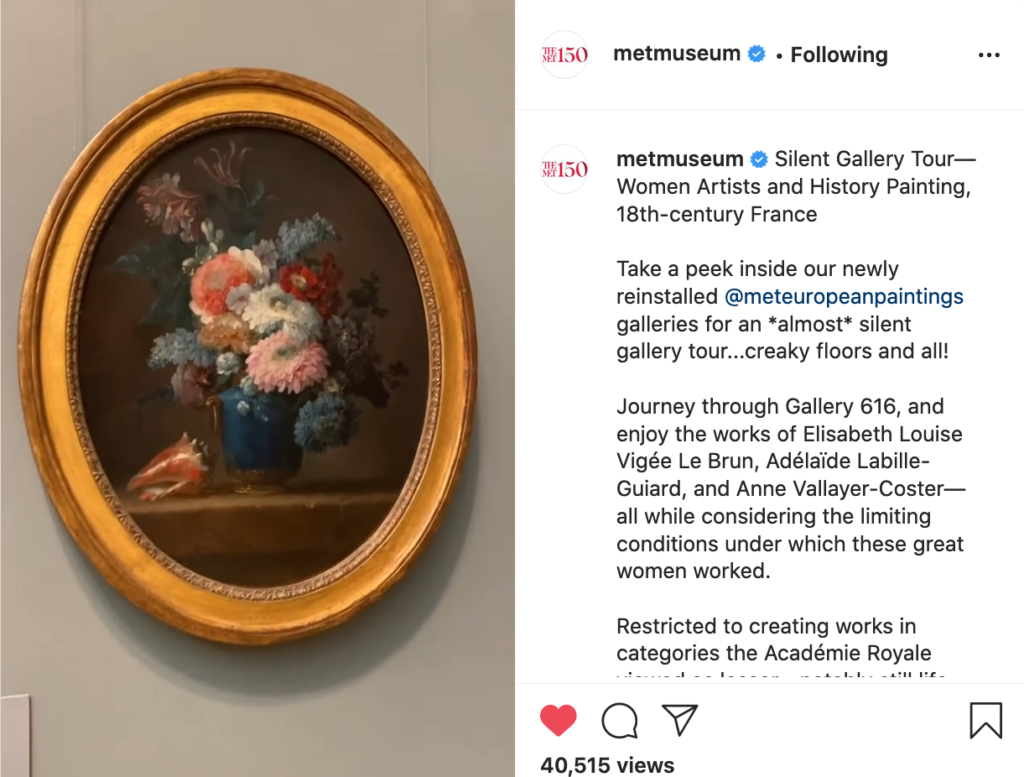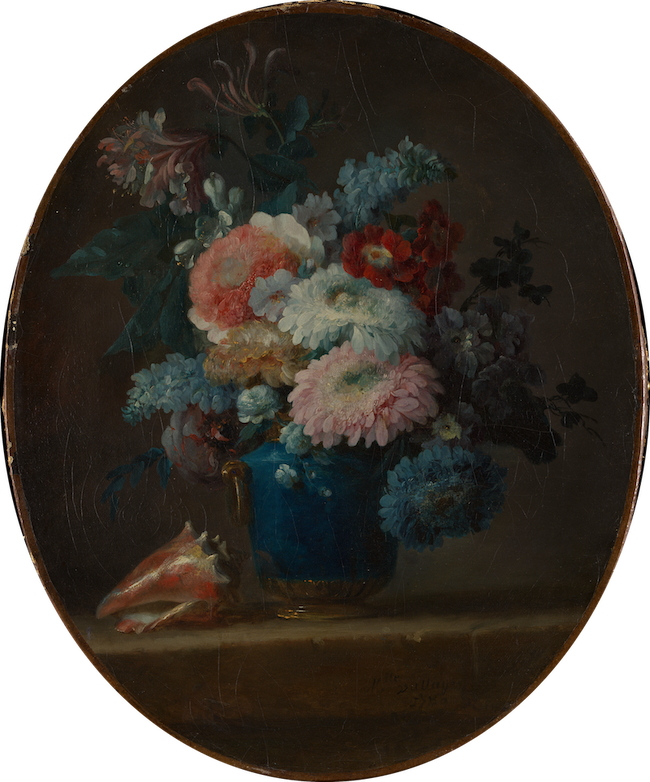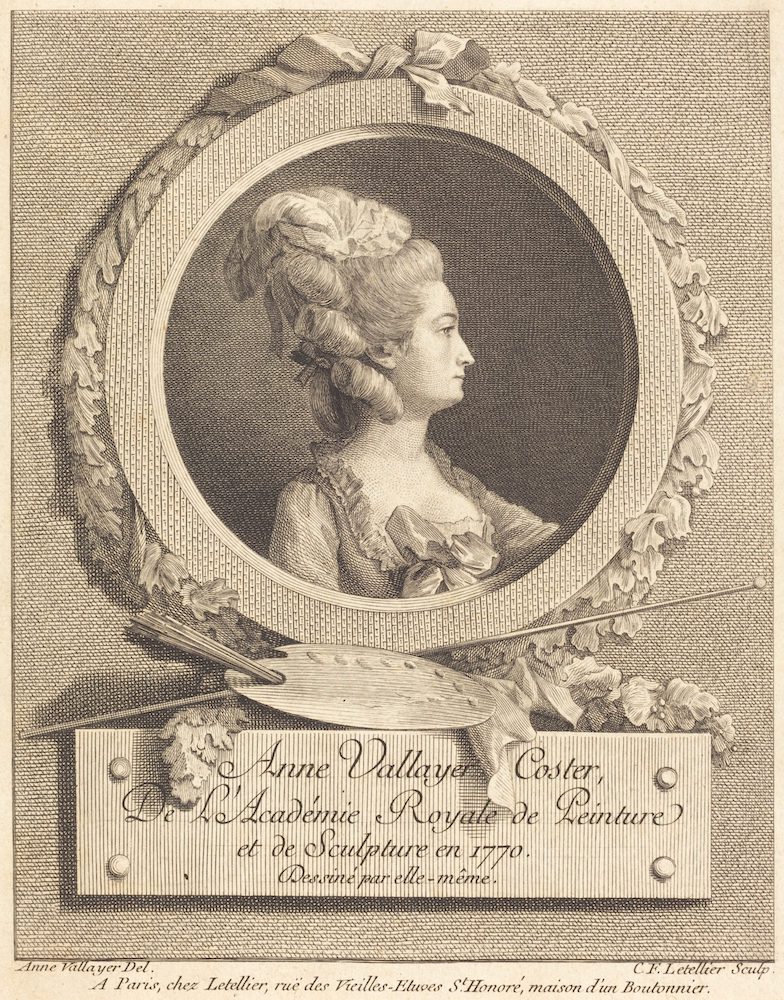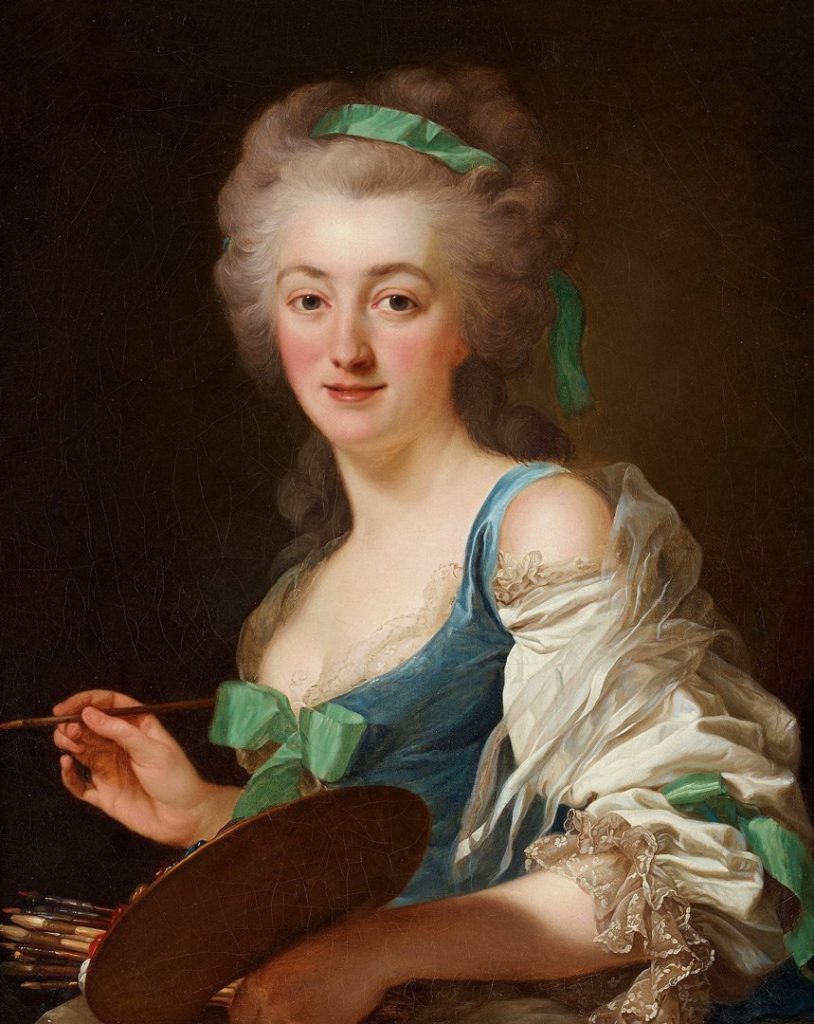Guest post by Kelsey Brosnan, PhD in Art History, Rutgers University
On December 12, 2020, the Metropolitan Museum of Art reopened its European Paintings galleries, largely closed to the public for the past two years. One of the newly reinstalled spaces highlights the work of female artists of eighteenth-century France: portraits by Elisabeth Louise Vigée Le Brun, Adélaïde Labille-Guiard, Marie Denise Villiers, Marie Victoire Lemoine—and a single still-life painting by Anne Vallayer-Coster (1744–1818).

The Met’s Vase of Flowers and Conch Shell (Figure 2) represents two subjects for which Vallayer-Coster is best known: flowers and shells. This painting was likely part of a trio of ovular canvases that Vallayer-Coster submitted to the Parisian Salon of 1781, each pairing a bouquet of flowers with delicate accessories. In this case, a spiky conch shell contrasts with exquisite jasmine, plush chrysanthemums, thick combs of hyacinth, a spray of honeysuckle, and a bulbous striped tulip, arranged in blue porcelain vase with gilt-bronze mounts.

Vallayer-Coster’s contemporaries debated these “seductive” qualities in her work, while emphasizing the modesty and charm of the artist herself. Critic Gabriel Bouquier praised the artist’s work at the Salon of 1775, writing, “This Demoiselle combines in her person all the graces of her sex.” An anonymous enthusiast concurred in 1777, writing the following verses:
Ah! I admire her character / Even more than her talent / She knows how decently / to combine agreeable pleasure / Candor and prudence / Intelligence and feeling. The common-place art of seduction / Has ever been foreign to her heart; / She pleases as she breathes / Without effort or reflection.
Paradoxically, other critics hailed the “seductive color, and the refined and vigorous touch” of her canvases, with one simply exclaiming “Superb! Truly superb! Observe how very truthful and seductive!”
L’Académicienne
Unsurprisingly, the notion of “seduction” also informed the debates about women artists in the French Royal Academy of Painting and Sculpture, the preeminent professional body for artists during the Ancien Régime. From its founding in 1643 until its dissolution during the French Revolution, the Academy admitted approximately 585 members; 15 of those were women. When Vallayer-Coster was admitted in 1770, there was only one other woman: miniaturist Marie-Thérèse Reboul Vien, wife of the history painter Joseph-Marie Vien. (Vigée Le Brun and Labille-Guiard would become members 13 years after Vallayer-Coster.)
Soon after Vallayer-Coster was accepted, the director of the Academy officially limited the number of women to four. As the secretary, Antoine Renou, later argued, academiciennes might distract male artists from their work or use their feminine charms to sway critics: “One knows how heavily women weigh in the balance of judgment and how even judges with the most integrity risk being seduced by them. The centuries of antiquity, like ours, give a thousand examples of seduction of this kind.”
Unlike her fellow académiciennes, Vallayer-Coster was unmarried and only twenty-five years old when she was admitted to the Academy (Figure 3). She was baptized on December 22, 1744 at the Église Saint-Hippolyte in Paris—276 years ago. Her father, Louis-Joseph Vallayer, trained as a goldsmith at the Gobelins Royal Manufactory before setting up his own workshop specializing in gold snuff boxes and military medals. He died just a few days before his daughter was admitted to the Academy, but it was undoubtedly with his support that Vallayer-Coster pursued a career as an artist.

Vallayer-Coster also benefited from her family’s connections to the creative community in Paris. Madeleine Françoise Basseporte, godmother to Vallayer-Coster’s youngest sister, was the official draftswoman of the Jardin des Plantes from 1742 until her death in 1780. Basseporte produced hundreds of vividly colored drawings of the botanical and marine specimens in the royal collection, and she may have trained Vallayer-Coster in the same tradition. Vallayer-Coster’s mother, Anne Desfontaines, was another important professional model: once widowed, she took over her late husband’s workshop and went on to outlive him by over twenty years.
Membership to the Academy entitled Vallayer-Coster to participate in the Salon—a biannual, public exhibition staged at the Salon Carré at the Louvre. The Salons were a crucial public platform for promoting her work. Vallayer-Coster submitted eleven paintings to her first Salon in 1771—including the triumphant Still Life with Sea Shells and Coral (Figure 4) with a now lost pendant. This painting appealed directly to the contemporary Parisian vogue for collecting exotic shells and displaying them in natural history cabinets.

Still Life with Coral and Sea Shells elicited ample praise from contemporary critics. Philosopher Denis Diderot, for example, declared the natural history painting and its pendant to be masterpieces of the genre. He specifically praised the arrangement, as well as the color and form, of the “polished shell bodies.” He concluded that Vallayer-Coster’s work was “excellent, vigorous, harmonious; it’s not Chardin, however, but if it’s less good than this master, it’s far above what is to be expected of a woman.”
“Mme. Vallayer-Coster, who painted flowers perfectly”
After her debut at the Salon, Vallayer-Coster developed a reputation as a flower painter; Vigée Le Brun described her in her memoirs: “Mme. Vallayer-Coster, who painted flowers perfectly.” This genre represented an important revenue stream for the artist. (Vallayer’s 1781 marriage contract to lawyer Jean-Pierre Coster reveals the profitability of her painting practice, the same year that she painted the Met’s Vase of Flowers and Conch Shell. The thirty-five-year-old bride brought to the marriage 14,000 livres in personal savings, in addition to a dowry of 20,000 livres. The groom’s premarital assets totaled 15,000 livres.) Two large pendants now at the Dallas Museum of Art, for example, were probably commissioned by the well-connected collector, Jean-Baptiste-François de Montullé. Bouquet of Flowers in a Blue Porcelain Vase and Bouquet of Flowers in a Terracotta Vase (Figures 5 and 6) are even more ambitious in composition and scale than the Met’s Vase of Flowers and Conch Shell.
In the first painting, a blue porcelain vase with gilded “rope” handles and four lion-paw feet is situated on a rough stone ledge. The luxurious vessel is filled with pink roses; purple daisies and violets; white-blue hydrangeas; bold red poppies; carnations; a budding hollyhock; orange day lilies; large white lilies with fuzzy orange stamens and blue irises with yellow-striped petals. Individual stalks of purple, red, and white chrysanthemum lie alongside the arrangement, as if waiting to fill a void in the bouquet.
The second, Bouquet of Flowers in a Terracotta Vase, also features familiar flowers (violets, hydrangeas, hollyhock), as well as several new varieties: graceful, tubular white calla lilies; robust red peonies; yellow zinnias; pale lilacs; and a fantastic poppy-shaped bloom with a thick cluster of pink and blue stamens. Finally, a single purple tulip, striped and dimpled, droops dramatically towards the rear of the composition. These flowers are set in a terracotta relief vase situated on a more elaborate, Louis XVI-style table.


Figure 6: Anne Vallayer-Coster, Bouquet of Flowers in a Terracotta Vase with Peaches and Grapes, 1776, Dallas Museum of Art.
Vallayer-Coster reserved her most abstract brushwork for the moist cruxes of the morning glories, violets, hydrangeas, and peonies. This is perhaps most evident in those two fantastic poppy flowers with a crush of pink and blue petals at the center, rendered with a flurry of haphazard strokes. Vallayer-Coster pushed this effect even further in the Met’s Vase of Flowers and Conch Shell: lush dabs of paint give form to individual petals of frilly chrysanthemum heads and hyacinth combs, while flecks of gold paint stand for the sweet secretions of the tubular honeysuckle (Figure 7).

Vallayer-Coster produced dozens of complex still life paintings and exhibited regularly at the Salon until her death in 1818. Her professional success can be attributed to her obvious artistic skill, but also to her strong professional relationships—including her friendship with the Swedish portraitist Alexandre Roslin. Roslin’s own wife, pastellist Marie-Suzanne Giroust, had also been admitted to the Academy in 1770, but died just two years later.
Roslin’s intimate, alluring portrait of Vallayer-Coster depicts the mature female artist at work, her palette and brush in hand (Figure 8). She meets the gaze of the viewer with an affable, satisfied expression. She is dressed in a state of dishabille: her décolletage is framed by silk blue stays, layered over lace-fringed chemise, the voluminous sleeves of which have slipped off her shoulders. Vallayer-Coster appears confident in her talents—and quite willing to wield “the graces of her sex” in order to achieve her goals.

This portrait, recently gifted to the Crocker Art Museum—in addition to other recent acquisitions of Vallayer-Coster paintings by the Kimbell Art Museum and the Nationalmuseum, Stockholm—has brought renewed attention to this long-overshadowed académicienne. Much has been made of the quiet beauty of her still lifes, but Vallayer-Coster’s paintings are anything but silent; they speak directly to the visceral textures of eighteenth-century Parisian life. Her still lifes certainly appeal to the eye—but neither can our fingers, tongues, ears or noses be indifferent to her work.
Dr. Kelsey Brosnan earned her PhD in Art History in 2018 from Rutgers University with a dissertation entitled “Seductive Surfaces: The Still Life Paintings of Anne Vallayer-Coster (1744–1818).” She has worked as a Research Assistant at the Metropolitan Museum of Art, the Doris Zemurray Stone Curatorial Fellow for European Art at the New Orleans Museum of Art, and a lecturer in the Art History Department at the University of Vermont. Follow her on Instagram at @kelseybrosnan.
Visit the Art Herstory Anne Vallayer-Coster resource page, here.
Other Art Herstory posts to do with French women artists:
Charlotte Eustache Sophie de Fuligny-Damas, Marquise de Grollier, by David Pullins
Louise Moillon: A pioneering painter of still life, by Lesley Stevenson
Marie Laurencin and the Autonomy of Self-Representation, by Mary Creed
The Many Faces of Suzanne Valadon, by Dr Suzanne Singletary
Marie-Thérèse Reboul Vien: Finding the Natural in the Neoclassical, by Tori Champion
Madeleine Françoise Basseporte’s Hyacinths at the French Court, by Mary Creed
Adélaïde Labille-Guiard: Artist, Friend, Teacher, by Dr. Jessica L. Fripp
Marie-Guillemine Benoist, Revolutionary Painter, by Dr. Paris Spies-Gans
The Theatrical Wonders of Jeanne Paquin’s Belle Époque Parisienne, by Julia Westerman
Victorine Meurent, More than a Model, by novelist Drēma Drudge
Paper Portraits: The Self-Fashioning of Esther Inglis, by Dr. Georgianna Ziegler
Other Art Herstory posts to do with 18th-century women artists:
Exhibiting Women: The Art of Professionalism in London and Paris, 1760–1830, by Paris Spies-Gans
Mary Linwood’s Balancing Act, by Heidi A. Strobel
A Short Reintroduction to the Life of Anna Dorothea Therbusch (1721–1782), by Dr. Christina K. Lindeman
Rosalba Carriera at The Frick Collection, by Dr. Xavier F. Salomon
Angelica Kauffmann: Grace and Strength, by Dr. Anita V. Sganzerla
Angelica Kauffman and Mary Moser: Founding Women Artists of the Royal Academy
“I feel again the violence of a curious desire”: Rare client testimonies on Rosalba Carriera’s erotic art, by Dr. Angela Oberer
Rediscovering the Once Visible: Eighteenth-Century Florentine Artist Violante Ferroni, by Dr. Ann Golob





Trackbacks/Pingbacks